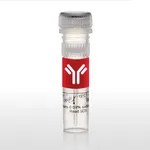
Thermo Fisher Scientific RhoA Recombinant Rabbit Monoclonal Antibody (036), FITC
✨AI 추천 연관 상품
AI가 분석한 이 상품과 연관된 추천 상품들을 확인해보세요
연관 상품을 찾고 있습니다...
Applications
Tested Dilution
Publications
Flow Cytometry (Flow)
Assay-Dependent
Product Specifications
Species Reactivity
Human
Host/Isotype
Rabbit / IgG
Expression System
HEK293 cells
Class
Recombinant Monoclonal
Type
Antibody
Clone
036
Immunogen
Recombinant Human RhoA protein
Conjugate
FITC FITC FITC
Excitation/Emission Max
498/517 nm View spectra 
Form
Liquid
Concentration
0.1 mg/mL
Purification
Protein A
Storage buffer
PBS with 0.5% BSA
Contains
0.03% ProClin 300
Storage conditions
4° C, store in dark, DO NOT FREEZE!
Shipping conditions
Ambient (domestic); Wet ice (international)
RRID
AB_2898731
Product Specific Information
May be stored for twelve months without detectable loss of activity. Protect from prolonged exposure to light and do not freeze. Sodium azide is toxic to cells and should be disposed of properly so flush with large volumes of water during disposal.
Target Information
RhoA regulates a signal transduction pathway linking plasma membrane receptors to the assembly of focal adhesions and actin stress fibers. It is involved in a microtubule-dependent signal that is required for the myosin contractile ring formation during cell cycle cytokinesis, and plays an essential role in cleavage furrow formation. RhoA is required for the apical junction formation of keratinocyte cell-cell adhesion, and serves as a target for the yopT cysteine peptidase from Yersinia pestis, vector of the plague, and Yersinia pseudotuberculosis, which causes gastrointestinal disorders. RhoA stimulates PKN2 kinase activity and may be an activator of PLCE1. It is activated by ARHGEF2, which promotes the exchange of GDP for GTP. It is essential for the SPATA13-mediated regulation of cell migration and adhesion assembly and disassembly. The MEMO1-RHOA-DIAPH1 signaling pathway plays an important role in ERBB2-dependent stabilization of microtubules at the cell cortex. It controls the localization of APC and CLASP2 to the cell membrane, via the regulation of GSK3B activity. In turn, membrane-bound APC allows the localization of the MACF1 to the cell membrane, which is required for microtubule capture and stabilization.
For Research Use Only. Not for use in diagnostic procedures. Not for resale without express authorization.
🏷️Thermo Fisher Scientific 상품 둘러보기
동일 브랜드의 다른 상품들을 확인해보세요

Thermo Fisher Scientific
Thermo Fisher Scientific Carbonic Anhydrase IX Recombinant Rabbit Monoclonal Antibody (053), FITC
779,700원

Thermo Fisher Scientific
Thermo Fisher Scientific SOD1 Recombinant Rabbit Monoclonal Antibody (106), FITC
652,000원

Thermo Fisher Scientific
Thermo Fisher Scientific RhoA Recombinant Rabbit Monoclonal Antibody (036), FITC
652,000원

Thermo Fisher Scientific
Thermo Fisher Scientific PDI Recombinant Rabbit Monoclonal Antibody (016), FITC
652,000원

Thermo Fisher Scientific
Thermo Fisher Scientific LILRA3 Recombinant Rabbit Monoclonal Antibody (060), PE
652,000원
배송/결제/교환/반품 안내
배송 정보
| 기본 배송비 |
| 교환/반품 배송비 |
|
|---|---|---|---|
| 착불 배송비 |
| ||
| 교환/반품 배송비 |
| ||
결제 및 환불 안내
| 결제수단 |
|
|---|---|
| 취소 |
|
| 반품 |
|
| 환급 |
|
교환 및 반품 접수
| 교환 및 반품 접수 기한 |
|
|---|---|
| 교환 및 반품 접수가 가능한 경우 |
|
| 교환 및 반품 접수가 불가능한 경우 |
|
교환 및 반품 신청
| 교환 절차 |
|
|---|---|
| 반품 절차 |
|
